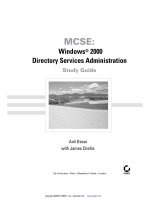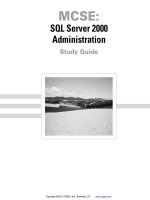Solaris™ Operating Environment– TCP/IPNetwork Administration ppt
Bạn đang xem bản rút gọn của tài liệu. Xem và tải ngay bản đầy đủ của tài liệu tại đây (3.48 MB, 820 trang )
Sun Microsystems, Inc.
MS BRM01-209
500 Eldorado Boulevard
Broomfield, Colorado 80021
U.S.A.
®
Solaris™OperatingEnvironment–
TCP/IPNetworkAdministration
Revision A, June 2000
SA-389
StudentGuide
Please
Recycle
Copyright 2000 Sun Microsystems, Inc., 901 San Antonio Road, Palo Alto, California 94303, U.S.A. All rights reserved.
This product or document is protected by copyright and distributed under licenses restricting its use, copying, distribution, and decompi-
lation. No part of this product or document may be reproduced in any form by any means without prior written authorization of Sun and
its licensors, if any.
Third-party software, including font technology, is copyrighted and licensed from Sun suppliers.
Parts of the product may be derived from Berkeley BSD systems, licensed from the University of California. UNIX is a registered trademark
in the U.S. and other countries, exclusively licensed through X/Open Company, Ltd.
Sun, Sun Microsystems, the Sun Logo, Solaris, ONC+, SunSoft, SunOS, Solstice, Solstice Site Manager, Solstice Domain Manager, Solstice
Enterprise Manager, Sun Management Center, SunATM, SunFastEthernet, Sun Quad FastEthernet, SunFDDI/S, and SunTRI/S are trade-
marks or registered trademarks of Sun Microsystems, Inc. in the U.S. and other countries.
All SPARC trademarks are used under license and are trademarks or registered trademarks of SPARC International, Inc. in the U.S. and
other countries. Products bearing SPARC trademarks are based upon an architecture developed by Sun Microsystems, Inc.
UNIX is a registered trademark in the U.S. and other countries, exclusively licensed through X/Open Company, Ltd.
The OPEN LOOK and Sun Graphical User Interface was developed by Sun Microsystems, Inc. for its users and licensees. Sun acknowledges
the pioneering efforts of Xerox in researching and developing the concept of visual or graphical user interfaces for the computer industry.
Sun holds a non-exclusive license from Xerox to the Xerox Graphical User Interface, which license also covers Sun’s licensees who imple-
ment OPEN LOOK GUIs and otherwise comply with Sun’s written license agreements.
U.S. Government approval required when exporting the product.
RESTRICTED RIGHTS: Use, duplication, or disclosure by the U.S. Government is subject to restrictions of FAR 52.227-14(g) (2)(6/87) and
FAR 52.227-19(6/87), or DFAR 252.227-7015 (b)(6/95) and DFAR 227.7202-3(a).
DOCUMENTATION IS PROVIDED "AS IS" AND ALL EXPRESS OR IMPLIED CONDITIONS, REPRESENTATIONS, AND WARRAN-
TIES, INCLUDING ANY IMPLIED WARRANTY OF MERCHANTABILITY, FITNESS FOR A PARTICULAR PURPOSE OR NON-IN-
FRINGEMENT, ARE DISCLAIMED, EXCEPT TO THE EXTENT THAT SUCH DISCLAIMERS ARE HELD TO BE LEGALLY INVALID.
iii
Copyright 1999 Sun Microsystems, Inc. All Rights Reserved. Enterprise Services June 2000, Revision A
Contents
About This Course xv
Course Goal xv
Course Overview xvi
Course Map xvii
Module-by-Module Overview xviii
Course Objectives xxiii
Skills Gained by Module xxiv
Guidelines for Module Pacing xxix
Topics Not Covered xxx
How Prepared Are You? xxxi
Introductions xxxii
How to Use Course Materials xxxiii
Course Icons and Typographical Conventions xxxv
Icons xxxv
Typographical Conventions xxxvii
Network Models 1-1
Objectives 1-1
Relevance 1-2
References 1-2
Standards Organizations 1-3
Protocols 1-5
Networking Models 1-6
ISO/OSI Seven-Layer Model 1-8
TCP/IP Five-Layer Model 1-9
Layered Model 1-11
Physical Layer 1-12
Hardware Layer 1-13
Network Interface Layer 1-15
Network Layer 1-16
Internet Layer 1-17
Transport Layer 1-18
Session Layer 1-20
Application Layer 1-21
iv Solaris Operating Environment–TCP/IP Network Administration
Copyright 1999 Sun Microsystems, Inc. All Rights Reserved. Enterprise Services June 2000, Revision A
Presentation Layer 1-22
Application Layer 1-23
Peer-to-Peer Communication 1-26
TCP/IP Protocols 1-28
Exercise: Reviewing the Module 1-30
Tasks 1-30
Exercise Summary 1-34
Task Solutions 1-35
Check Your Progress 1-38
Think Beyond 1-39
Introduction to Local Area Networks 2-1
Objectives 2-1
Relevance 2-2
References 2-2
What is Computer Networking? 2-3
Introduction to Local Area Network 2-4
Benefits of a LAN 2-5
LAN Architecture 2-5
Network Media 2-6
IEEE Identifiers 2-8
10BASE-5 (Thick Ethernet) 2-9
10BASE-2 (Thin Ethernet) 2-9
10BASE-T (Twisted-Pair Ethernet) 2-10
10BASE-F 2-10
100BASE-TX 2-12
100BASE-T4 2-12
100BASE-FX (Fast Fiber Optic Ethernet) 2-13
1000BASE-X 2-13
1000BASE-T 2-15
Twisted-Pair Cabling 2-16
Straight-Through Cable 2-16
Crossover Cable 2-17
Network Interface Card 2-18
LAN Components 2-19
Switches 2-21
LAN Topology 2-23
Bus Configuration 2-23
Star Configuration 2-24
Ring Configuration 2-26
LAN Methodologies 2-27
Ethernet-II 2-27
Asynchronous Transfer Mode 2-28
Token Ring – IEEE 802.5 2-29
Fiber Distributed Data Interface 2-30
Sun Communications Controllers 2-32
v
Copyright 1999 Sun Microsystems, Inc. All Rights Reserved. Enterprise Services June 2000, Revision A
ATM 2-32
Ethernet 2-32
Fast Ethernet 2-33
FDDI 2-33
Token Ring 2-33
Gigabit Ethernet 2-33
Mixed Media Ethernet Network 2-34
Exercise: Reviewing the Module 2-35
Preparation 2-35
Tasks 2-36
Exercise Summary 2-39
Task Solutions 2-40
Optional Exercise: Identifying Lab Components 2-42
Tasks 2-42
Exercise Summary 2-43
Check Your Progress 2-44
Think Beyond 2-45
Ethernet Interface 3-1
Objectives 3-1
Relevance 3-2
References 3-2
Introduction to Ethernet 3-3
Ethernet Major Elements 3-4
The CSMA/CD Access Method 3-5
Ethernet Collisions 3-7
Collision Rates 3-7
Input Errors 3-8
Output Errors 3-8
Ethernet Address 3-9
Ethernet-II Frame Analysis 3-14
Maximum Transfer Unit 3-17
Ethernet Error Checking 3-18
TCP/IP Configuration Files 3-20
/etc/hostname.interface File 3-20
/etc/nodename File 3-20
/etc/inet/hosts File 3-20
TCP/IP Configuration Files 3-21
Loopback Address 3-21
Network Utilities 3-22
snoop 3-22
netstat 3-27
ifconfig 3-28
ndd 3-30
Exercise: Using the snoop, and netstat Commands 3-32
Preparation: 3-32
vi Solaris Operating Environment–TCP/IP Network Administration
Copyright 1999 Sun Microsystems, Inc. All Rights Reserved. Enterprise Services June 2000, Revision A
Tasks 3-32
Exercise: Using the ndd Command 3-36
Tasks 3-36
Exercise Summary 3-38
Task Solutions 3-39
Check Your Progress 3-46
Think Beyond 3-47
ARP and RARP 4-1
Objectives 4-1
Relevance 4-2
References 4-2
Introduction to Address Resolution 4-3
Why ARP Is Required 4-4
Address Resolution Protocol 4-6
ARP Request 4-6
ARP Reply 4-8
ARP Reply Caching 4-9
ARP Table Management 4-10
Reverse Address Resolution 4-13
Diskless Systems 4-13
JumpStart Systems 4-13
RARP Request 4-14
RARP Reply 4-15
Troubleshooting the in.rarpd Server 4-16
Exercise: Understanding ARP 4-18
Tasks 4-18
Exercise Summary 4-22
Task Solutions 4-23
Check Your Progress 4-29
Think Beyond 4-30
Internet Layer 5-1
Objectives 5-1
Relevance 5-2
References 5-2
Introduction to the Internet 5-3
Berkeley Software Distribution 5-3
Rapid Growth 5-4
The Future 5-4
Internet Layer 5-6
Datagrams 5-7
Internet Control Message Protocol 5-7
Fragmentation 5-7
Classful IPv4 Addressing 5-8
Class A – Very Large Networks (up to 16 Million Hosts) 5-9
Class B – Large Networks (up to 65,000 Hosts) 5-9
vii
Copyright 1999 Sun Microsystems, Inc. All Rights Reserved. Enterprise Services June 2000, Revision A
Class C – Small and Mid-Sized Networks
(up to 254 Hosts) 5-10
Class D – Multicast Address 5-10
Special IPv4 Addresses 5-11
IPv4 Broadcast Addresses 5-11
Reserved Network and Host IPv4 Values 5-12
IPv4 Netmasks 5-13
Computation of Network Numbers 5-15
Defining Subnets 5-18
Address Hierarchy 5-18
Extended Network Number 5-18
Computation of the Extended Network Number 5-19
Non-Byte Bounded Subnet Masks 5-20
Computing the Broadcast Address 5-21
The Logical NOT Operator 5-21
The Logical OR Operator 5-22
Recommended Subnet Masks 5-24
Permanent Subnet Masks 5-27
Variable Length Subnet Masks 5-28
VLSM Advantages 5-28
Efficient Use of IP Address Space 5-29
Route Aggregation 5-30
Associated Protocols 5-30
Network Interface Configuration 5-31
/etc/rcS.d/S30network.sh 5-32
/sbin/ifconfig Command 5-33
Examining Network Interfaces 5-34
Network Interface Configuration Examples 5-36
Virtual Interfaces 5-38
Troubleshooting the Network Interface 5-47
Exercise: Becoming Familiar With the Internet Protocol Lab 5-48
Tasks 5-48
Exercise: Becoming Familiar With Virtual Interfaces Lab 5-54
Exercise Summary 5-56
Task Solutions 5-57
Check Your Progress 5-69
Think Beyond 5-70
Routing 6-1
Objectives 6-1
Relevance 6-2
References 6-2
Introduction to Routing 6-3
Introduction to Routing 6-4
Direct Routing 6-4
Indirect Routing 6-4
viii Solaris Operating Environment–TCP/IP Network Administration
Copyright 1999 Sun Microsystems, Inc. All Rights Reserved. Enterprise Services June 2000, Revision A
Table-Driven Routing 6-5
Routing Schemes 6-6
Static Routing 6-6
Dynamic Routing 6-7
Displaying the Routing Table 6-12
6-12
Manually Manipulating the Routing Table 6-13
Default Routing 6-15
Routing Algorithm 6-16
Internet Control Messaging Protocol 6-19
Internet Control Messaging Protocol 6-20
Router Configuration 6-21
Autonomous Systems 6-24
Gateway Protocols 6-25
Exterior Gateway Protocol 6-25
Border Gateway Protocol 6-27
Classless Interdomain Routing 6-29
Interior Gateway Protocol 6-33
Routing Daemons 6-39
Network Router Discovery 6-41
Routing Initialization 6-43
Multihomed Host 6-44
/etc/inet/networks File 6-46
Troubleshooting Router Configuration 6-47
Exercise: Enabling Routing 6-49
Preparation 6-49
Tasks 6-51
Exercise Summary 6-65
Task Solutions 6-66
Check Your Progress 6-84
Think Beyond 6-85
Transport Layer 7-1
Objectives 7-1
Relevance 7-2
References 7-2
Introduction to the Transport Layer 7-3
Types of Protocols 7-5
Connection-Oriented Protocols 7-5
Connectionless Protocols 7-6
Stateful Compared to Stateless Protocols 7-7
Stateful Protocols 7-7
Stateless Protocols 7-8
Reliable Compared to Unreliable Protocols 7-9
Reliable Protocol 7-9
Unreliable Protocol 7-9
ix
Copyright 1999 Sun Microsystems, Inc. All Rights Reserved. Enterprise Services June 2000, Revision A
Transport Protocols 7-10
User Datagram Protocol 7-11
Unreliable and Connectionless 7-11
Non-Acknowledged 7-12
Datagrams 7-12
Transmission Control Protocol 7-13
Unstructured Stream Orientation 7-13
Virtual Circuit Connection 7-14
Buffered Transfer 7-14
Full Duplex Connection 7-14
TCP Flow Control 7-15
Sliding Window Principle 7-15
Congestion Window 7-16
Exercise: Reviewing the Module 7-17
Tasks 7-17
Exercise Summary 7-18
Task Solutions 7-19
Check Your Progress 7-21
Think Beyond 7-22
Client-Server Model 8-1
Objectives 8-1
Relevance 8-2
References 8-2
The Client-Server Model 8-3
ONC+ Technologies 8-5
TI-RPC 8-7
XDR 8-8
TLI 8-8
Sockets 8-8
NFS 8-9
NIS+ 8-9
Port Numbers 8-10
How a Server Process Is Started 8-12
How an Internet Service Process Is Started 8-13
The inetd Process 8-13
The /etc/inet/inetd.conf File 8-13
Remote Procedure Call 8-14
How an RPC Process Is Started 8-15
The /etc/inet/inetd.conf File 8-15
Status Commands 8-16
The /usr/bin/rpcinfo Command 8-17
The /usr/bin/netstat -a Command 8-18
Exercise: Exploring the Client/Server Process 8-19
Preparation 8-19
Tasks 8-20
x Solaris Operating Environment–TCP/IP Network Administration
Copyright 1999 Sun Microsystems, Inc. All Rights Reserved. Enterprise Services June 2000, Revision A
Exercise Summary 8-26
Task Solutions 8-27
Check Your Progress 8-36
Think Beyond 8-37
DHCP 9-1
Objectives 9-1
Relevance 9-2
References 9-2
Dynamic Host Configuration Protocol 9-3
Benefits of Using DHCP 9-4
How DHCP Uses BOOTP 9-5
DHCP Features 9-6
DHCP Information Repository 9-7
DHCP Client-Server 9-8
Client Side 9-8
Server Side 9-11
Server Databases 9-13
dhcp_network Entry Format 9-14
dhcp_network Examples 9-17
dhcptab Entry Format 9-18
dhcptab 9-20
Symbols 9-20
Macro 9-20
dhcptab Examples 9-21
Lease Time Policy 9-22
Choosing Data Store 9-25
DHCP Server Configuration 9-26
Using the dhcpconfig Utility 9-26
DHCP Administration Commands 9-55
pntadm 9-55
dhtadm 9-56
Troubleshooting DHCP 9-58
snoop 9-60
DHCP Server Debug Mode 9-62
Restart the DHCP Server 9-63
Exercise: Configuring and Troubleshooting DHCP 9-64
Preparation 9-64
Tasks 9-66
Exercise Summary 9-78
Task Solutions 9-79
Check Your Progress 9-100
Think Beyond 9-101
Introduction to Network Management Tools 10-1
Objectives 10-1
Relevance 10-2
xi
Copyright 1999 Sun Microsystems, Inc. All Rights Reserved. Enterprise Services June 2000, Revision A
References 10-2
Network Management 10-3
Introduction to SNMP 10-6
How SNMP Works 10-6
Structure of Management Information 10-7
Management Information Bases 10-9
SNMP-based Management Applications 10-12
Exercise: Introducing Network Management Tools 10-13
Preparation 10-13
Tasks 10-13
Optional Exercise: Installing UCD-SNMP 10-16
Installing the GNU C Compiler 10-16
Exercise Summary 10-25
Task Solutions 10-26
Check Your Progress 10-38
Think Beyond 10-39
Domain Name System 11-1
Objectives 11-1
Relevance 11-2
References 11-2
A Brief History of DNS 11-3
Early Internet Naming Problems 11-4
The Solution 11-5
DNS Namespace 11-7
Domains 11-7
Structure 11-9
Domain Naming 11-11
Domain Naming Rules 11-12
The in-addr.arpa. Domain 11-12
Zones of Authority 11-13
DNS Servers 11-14
Root Servers 11-14
Primary (Master) Servers 11-15
Secondary (Slave) Servers 11-15
Caching-Only Servers 11-16
Forwarding Servers 11-17
DNS Answers 11-18
Authoritative Answers 11-18
Non-Authoritative Answers 11-19
DNS Name Resolution Process 11-20
Client Resolver 11-20
Resolution Process 11-22
DNS Server Configuration 11-24
BIND Configuration File 11-25
DNS Resource Records 11-27
xii Solaris Operating Environment–TCP/IP Network Administration
Copyright 1999 Sun Microsystems, Inc. All Rights Reserved. Enterprise Services June 2000, Revision A
/var/named/named.root File 11-31
DNS Server Configuration 11-34
/var/named/domain-info File 11-34
/var/named/inverse-domain-info File 11-37
/var/named/loopback-domain-info File 11-39
Final Configuration Note 11-40
Client/Server Common File Setup 11-41
/etc/nsswitch.conf 11-41
/etc/resolv.conf 11-41
Testing DNS Information 11-43
nslookup 11-43
BIND Debugging Tools 11-46
pkill -INT in.named 11-46
pkill -USR1 in.named 11-48
pkill -USR2 in.named 11-48
pkill -HUP in.named 11-48
Secondary DNS Server Setup 11-49
/etc/named.conf File on Secondary Server 11-49
/var/named/domain-info File on Primary Server 11-51
Testing and Debugging 11-51
DNS Security 11-52
Using the BIND Configuration File 11-52
Restricting Queries 11-53
Preventing Unauthorized Zone Transfers 11-54
Miscellaneous DNS Topics 11-56
DNS Configuration File $ Directives 11-56
h2n 11-58
DIG 11-58
DNS Resources 11-59
Exercise: Installing DNS 11-61
Preparation 11-61
Tasks 11-63
Exercise Summary 11-75
Task Solutions 11-76
Check Your Progress 11-88
Think Beyond 11-89
Introduction to NTP 12-1
Objectives 12-1
Relevance 12-2
Additional Resources 12-3
What is Network Time Protocol? 12-4
What is UTC? 12-4
NTP Applications 12-5
NTP Terms 12-6
Defining an NTP Environment 12-8
xiii
Copyright 1999 Sun Microsystems, Inc. All Rights Reserved. Enterprise Services June 2000, Revision A
How Does NTP Work? 12-9
Configuring NTP 12-11
Configuring an NTP Server 12-11
Configuring an NTP Client 12-15
Logging and Daemon Control 12-16
Viewing NTP syslog Logs 12-16
Starting and Stopping the NTP Daemon 12-17
Monitoring Systems Running the xntpd Daemon 12-18
Exercise: Configuring NTP 12-21
Preparation 12-21
Tasks 12-21
Exercise Summary 12-25
Task Solutions 12-26
Check Your Progress 12-32
Think Beyond 12-33
Network Troubleshooting 13-1
Objectives 13-1
Relevance 13-2
References 13-2
Troubleshooting 13-3
Using ping as a Troubleshooting Tool 13-5
Common Network Problems 13-24
Connectivity Problems 13-26
Troubleshooting Techniques 13-28
The Application Layer 13-28
The Transport Layer and the Internet Layer 13-29
The Network Interface Layer 13-29
The Physical Layer 13-29
Troubleshooting Scenarios 13-30
Multi-Homed System Acts as Core Router 13-30
Faulty Cable 13-33
Duplicate IP Address 13-36
Duplicate MAC Address 13-39
Exercise: Troubleshooting Networks 13-41
Preparation 13-41
Tasks 13-42
Exercise Summary 13-48
Task Solutions 13-49
Check Your Progress 13-58
Think Beyond 13-59
Introduction to IPv6 14-1
Objectives 14-1
Relevance 14-2
Additional Resources 14-2
IPv6 History 14-4
xiv Solaris Operating Environment–TCP/IP Network Administration
Copyright 1999 Sun Microsystems, Inc. All Rights Reserved. Enterprise Services June 2000, Revision A
Why Use IPv6? 14-5
Features of IPv6 14-6
Ethernet Frame: IPv6 14-7
IPv6 Hierarchical Addressing 14-10
IPv6 Autoconfiguration 14-11
What Does IPv6 Autoconfiguration Do? 14-11
Stateful Autoconfiguration 14-12
Stateless Autoconfiguration 14-12
Duplicate Address Detection 14-13
Router Detection 14-14
Autoconfiguration Address Calculation Example 14-15
Aggregatable Global Unicast Address Types 14-19
Link-Local Unicast Address Types 14-19
Site-Local Unicast Address Types 14-19
Compressing Addresses 14-20
Mixing IPv4 and IPv6 Addresses 14-21
Prefixing Addresses and IPv6 Subnetting 14-22
IPv6 Addressing 14-23
Multicast Address Types 14-24
Internet Layer 14-27
ICMPv6 14-28
IGMP 14-31
ARP and RARP 14-31
Neighbor Discovery Protocol 14-32
Neighbor Discovery and ICMP 14-34
Unicast Address Allocation Scheme 14-36
Unspecified Addresses 14-36
Loopback Addresses 14-37
Embedded IPv4 Addresses 14-37
Using the Dual-stack Approach in IPv6 14-38
Enabling IPv6 14-38
IPv6 files 14-39
Using the netstat Utility 14-41
Using the ifconfig Utility 14-43
Configuring Logical IPv6 Interfaces 14-44
Routing IPv6 14-45
Exercise: Configuring IPv6 14-47
Preparation 14-47
Tasks 14-47
Exercise Summary 14-55
Task Solutions 14-56
Check Your Progress 14-68
Think Beyond 14-69
xv
Copyright 2000 Sun Microsystems, Inc. All Rights Reserved. Enterprise Services June 2000, Revision A
AboutThisCourse
Course Goal
The Solaris™ Operating Environment- TCP/IP Network Administration
course teaches you the advanced administration skills required to
plan, create, administer, and troubleshoot a local area network (LAN).
xvi Solaris™ Operating Environment–TCP/IP Network Administration
Copyright 2000 Sun Microsystems, Inc. All Rights Reserved. Enterprise Services June 2000, Revision A
Course Overview
This course provides hands-on experience with network configuration,
network troubleshooting; Domain Name System (DNS); Network
Time Protocol (NTP); Dynamic Host Configuration Protocol (DHCP);
and IPv6.
About This Course xvii
Copyright 2000 Sun Microsystems, Inc. All Rights Reserved. Enterprise Services June 2000, Revision A
Course Map
The course map enables you to see what you have accomplished and
where you are going in reference to the course goal.
Network
Models
Introduction
to Local
Ethernet
Interface
ARP and
Internet
Layer
Routing
Transport
Layer
Client-Server
Model
DHCP
Introduction
to Network
Management
Tools
Domain
Name
System
Applications and Troubleshooting
Local Area Network
IPv6
Client/Server
Subnetting
RARP
Introduction
to NTP
Network
Trouble-
shooting
Introduction
to IPv6
Area Networks
xviii Solaris™ Operating Environment–TCP/IP Network Administration
Copyright 2000 Sun Microsystems, Inc. All Rights Reserved. Enterprise Services June 2000, Revision A
Module-by-Module Overview
This course contains the following modules:
● Module 1 – “Network Models”
In this module, you learn about the International Organization for
Standardization/Open Systems Interconnection (ISO/OSI) and
Transmission Control Protocol/Internet Protocol (TCP/IP)
networking models.
Lab exercise – Review network models
● Module 2 – “Introduction to Local Area Networks”
This module covers the LAN concepts and terminology required
for the more complex concepts taught in later modules.
Lab exercise – Review LAN architecture and components
About This Course xix
Copyright 2000 Sun Microsystems, Inc. All Rights Reserved. Enterprise Services June 2000, Revision A
Module-by-Module Overview
● Module 3 – “Ethernet Interface”
In this module, you learn what role the Ethernet interface
(Hardware layer) plays in TCP/IP architecture. Solaris™
Operating Environment- (“Solaris”) based network monitoring
utilities is introduced.
Lab exercise – Monitor Ethernet hardware operation using Solaris-
based monitoring utilities such as netstat and snoop
● Module 4 – “ARP and RARP”
In this module, you learn how TCP/IP resolves Ethernet addresses
to Internet addresses and Internet addresses to Ethernet addresses.
The arp utility is introduced.
Lab exercise – Monitor Address Resolution Protocol (ARP) and
Reverse Address Resolution Protocol (RARP) operations using
Solaris-based monitoring utilities such as arp and snoop
● Module 5 – “Internet Layer”
This module examines Internet address version IPv4. In this
module, you learn how to configure network interfaces using the
ifconfig command. You also learn how subnets are defined.
Included in this module is a detailed description of the subnet
mask.
Lab exercise – Configure network interfaces for LAN
communication
● Module 6 – “Routing”
In this module, you learn how TCP/IP routes data between
networks. Various routing protocols will be explored.
Lab exercise – Review key routing concepts, configure a LAN with
subnetworks, and configure hosts for routing between the subnets
xx Solaris™ Operating Environment–TCP/IP Network Administration
Copyright 2000 Sun Microsystems, Inc. All Rights Reserved. Enterprise Services June 2000, Revision A
Module-by-Module Overview
● Module7–“Transport Layer”
This module covers the TCP/IP Transport layer and the TCP and
User Datagram Protocol (UDP) protocols.
Lab exercise – Review key Transport layer concepts
● Module 8 – “Client-Server Model”
In this module, you learn about the relationship of client/server
hosts on the network. Remote procedure call (RPC) services are
also covered.
Lab exercise – Explore how client processes find and connect to
server processes and the two ways that server processes can be
started
● Module 9 – “DHCP”
You learn to dynamically allocate IP addresses to networked hosts
in this module. Detailed address leasing and macro file
configuration are also examined.
Lab exercise – Configure a DHCP server and clients
About This Course xxi
Copyright 2000 Sun Microsystems, Inc. All Rights Reserved. Enterprise Services June 2000, Revision A
Module-by-Module Overview
● Module 10 – “Introduction to Network Management Tools”
In this module, you learn about Simple Network Management
Protocol (SNMP) and SNMP-based management applications.
Lab exercise – Review key network management tool concepts
● Module 11 – “Domain Name System”
You learn how TCP/IP resolves host names to IP addresses in this
module. DNS configuration and troubleshooting are also covered.
Lab exercise – Configure a DNS server with clients
● Module 12 – “Introduction to NTP”
In this module, you learn about NTP, including client and server
configuration and NTP utilities.
Lab exercise – Configuration of a NTP server and client
xxii Solaris™ Operating Environment–TCP/IP Network Administration
Copyright 2000 Sun Microsystems, Inc. All Rights Reserved. Enterprise Services June 2000, Revision A
Module-by-Module Overview
● Module 13 – “Network Troubleshooting”
In this module, you learn basic network troubleshooting strategies.
These troubleshooting strategies employ the networking tools and
concepts explored earlier in this course.
Lab exercise – Troubleshoot common networking problems
● Module 14 – “Introduction to IPv6”
This module focuses on IPv6; you learn what IPv6 is, how to
configure IPv6 on a system, and how to use existing network
utilities in an IPv6 environment.
Lab exercise – Configure IPv6 and use network utilities to examine
behavior of an IPv6 network
About This Course xxiii
Copyright 2000 Sun Microsystems, Inc. All Rights Reserved. Enterprise Services June 2000, Revision A
Course Objectives
Upon completion of this course, you should be able to:
● Understand the OSI layer terminology and TCP/IP technology,
and identify the major protocols of the TCP/IP networking model
● Understand and configure routing and routing tables
● Understand and configure subnet masks including variable length
masks
● Add Internet and RPC services
● Implement DHCP
● Use network troubleshooting tools to maintain the network
● Understand and configure DNS
● Identify DNS security issues
● Understand and configure NTP
● Understand, configure, and monitor IPv6
● Troubleshoot common network faults
xxiv Solaris™ Operating Environment–TCP/IP Network Administration
Copyright 2000 Sun Microsystems, Inc. All Rights Reserved. Enterprise Services June 2000, Revision A
Skills Gained by Module
The skills for Solaris™ Operating Environment–TCP/IP Network
Administration are shown in column 1 of the matrix below. The black
boxes indicate the main coverage for a topic; the gray boxes indicate
the topic is briefly discussed.
Module
Skills Gained 1 2 3 4 5 67891011121314
Determine benefits of a LAN
Identify LAN components
Define the following networking-related
terms:
topology, backbone, segment,
repeater, bridge, router, gateway,
networking model, protocol, layer, and
frame
Identify the function of each layer in the
OSI networking model
Identify the function of each layer in the
TCP/IP networking model
Describe how applications use the
TCP/IP suite to exchange data through
Ethernet networks
Describe peer-to-peer communications
Define the following terms: Ethernet,
packet, and maximum transfer unit
Describe the different Ethernet standards
Describe Ethernet addresses
Describe the components of an Ethernet
frame
Describe the concept of encapsulation
Describe the purpose of Carrier Sense,
Multiple Access/Collision Detection
(CSMA/CD)
Define an Ethernet broadcast address
Use the commands netstat and snoop
About This Course xxv
Copyright 2000 Sun Microsystems, Inc. All Rights Reserved. Enterprise Services June 2000, Revision A
Define address resolution
Describe the network configuration
process used in system start-up
Describe network configuration files and
scripts that are used to configure the
network interface
Define the terms: IP, datagrams, and
fragmentation
List the four IPv4 address classes
Define the network number
Identify an Ethernet address, an IP
address, and a broadcast address
Use the ifconfig command to configure
the network interface(s)
Verify and troubleshoot the network
interface
Describe the routing algorithm
Define the following routing terms: table-
driven routing, static routing, dynamic
routing
, and default routing
Use the in.routed and in.rdisc
processes
Employ the Routing Information
Protocol (RIP) and Router Discovery
(RDISC) protocols
Describe the /etc/init.d/inetinit
routing start-up script
Use the route and netstat commands
Use the /etc/defaultrouter,
/etc/inet/networks, and
/etc/gateways files
Configure a router
Define subnetting
Module
Skills Gained 1 2 3 4 5 67891011121314









